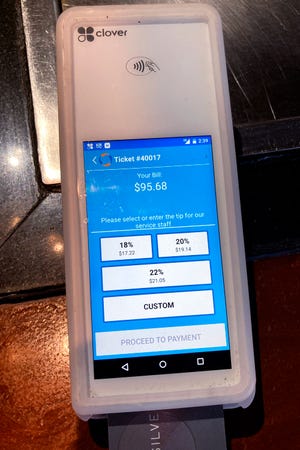Why is every place asking for tips?
Tipping may often be the right thing to do, but traditionally it's been a choice whether at a diner or a barbershop. Nowadays, however, many Americans feel the pressure to tip pops up everywhere – even when you’ve served yourself.
IPads stationed in spots ranging from coffee shops to airport kiosks are automatically prompting shoppers to leave a service charge, and that's leading to “tipping fatigue’, experts say.
Why does America tip so much?
Despite frequent grousing, Americans are tipping more than they have previously. Square, which provides many of the point-of-sale iPads customers are connecting with, says that total tips paid in the fourth quarter of last year at full-service restaurants rose 16.5% as compared to the previous year and 15.9% at quick-service restaurants.
Data from the restaurant management software company Toast found diners were still tipping between 15% and 20%. Average tips for full-service eateries were the same in the second and third quarters, holding at 19.6%, while quick-service restaurants saw the average tip percentage drop a beat, from 16.9% to 16.8%, Toast said.
Self-checkout asking for tips
Almost 20% of Americans are giving tips for a broader array of services, and roughly half say they’ve left a gratuity when they typically wouldn't have because an iPad prompted them to, according to a September survey of more than 1,000 people by PlayUSA, a website that covers the gambling industry.
Are people tipping less?
Though tipping at restaurants has stayed relatively strong, some surveys have found a large number of consumers are paring their tips overall.
Higher prices have led 17% of Americans to tip less, according to PlayUSA, while a November survey from restaurant tech company Popmenu found 43% of those surveyed tipped servers 20% or more in 2022, a steep drop from the 56% who offered a similar amount the previous year.
"People are seeing it at every interaction," said Lizzie Post, co-author of the book "Emily Post's Etiquette, The Centennial Edition." "So it's not like just when you go in for food or the service industry, you're seeing it in retail experiences, which was totally unexpected, and people weren't feeling good about it."

TipTokThese TikToks could make you question your tipping habits
Americans growing tired of tipping:But tips are actually growing. What's happening?
Inflation is slowing downGrocery costs slow, curbing stubbornly high consumer prices
Why is tipping so big in America?
Tips have played a key role in restaurants, where workers typically earn less than the minimum wage and rely on service charges to boost their income.
Now that customers are constantly prompted to leave tips for a range of services, some businesses even mention tips in their job listings to try and entice applicants. But tips aren’t a sure thing unless they’re automatically tacked onto a customer’s bill.
Stop asking for tips
Some restaurants are building the gratuity into the bill to make sure their employees’ ability to make the money they need doesn’t depend on the whims of the customer.
Joey Ward, chef and owner of Southern Belle and Georgia Boy in Atlanta told USA TODAY that he switched to a service-inclusive model in July. That means the check for each guest now includes a 25% charge that is ultimately split among the staff, helping to cover paid vacation time.
“(We wanted to) provide a better quality of life for our staff,” Ward said. “Why not just (have customers) pay a price and have it cover the business's costs instead of hoping that we did a good enough job for you to think that we deserve to eat or pay our rent?”
Gen Z turns to cash:Dollar dollar bill y'all: Gen Z is using cash more than ever in the face of inflation
What is the general rule for tipping?
Every service doesn’t require a tip.
For instance, while a 15% to 20% gratuity is expected when you dine out, leaving spare change or a few dollars in a coffee shop's tip jar is totally up to you.
"The workers at these establishments are usually paid in a different way from restaurant workers, which is why this is a little bit different," Post said.
Tipping screens are basically the same as a tip jar except you need to hit “no tip’’ on the screen if you’re not wanting to pay a gratuity, Post said.
You can make your decision depending on the circumstances. If your barista had to whip up your latte as opposed to you grabbing a beverage from a shelf, for example, or they were juggling you amid a bunch of customers, you might want to give them something extra – and 10% tends to be the norm, Post said.
+
No comments: